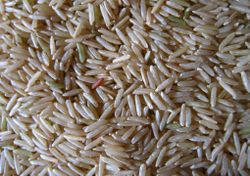MOUNTAIN VIEW, Calif. – Many parts of America, long considered the breadbasket of the world, are now confronting a once unthinkable phenomenon: food rationing. Major retailers in New York, in areas of New England, and on the West Coast are limiting purchases of flour, rice, and cooking oil as demand outstrips supply. There are also anecdotal reports that some consumers are hoarding grain stocks.

At a Costco Warehouse in Mountain View, Calif., yesterday, shoppers grew frustrated and occasionally uttered expletives as they searched in vain for the large sacks of rice they usually buy.
“Where’s the rice?” an engineer from Palo Alto, Calif., Yajun Liu, said. “You should be able to buy something like rice. This is ridiculous.”

The bustling store in the heart of Silicon Valley usually sells four or five varieties of rice to a clientele largely of Asian immigrants, but only about half a pallet of Indian-grown Basmati rice was left in stock. A 20-pound bag was selling for $15.99.
“You can’t eat this every day. It’s too heavy,” a health care executive from Palo Alto, Sharad Patel, grumbled as his son loaded two sacks of the Basmati into a shopping cart. “We only need one bag but I’m getting two in case a neighbor or a friend needs it,” the elder man said.
The Patels seemed headed for disappointment, as most Costco members were being allowed to buy only one bag. Moments earlier, a clerk dropped two sacks back on the stack after taking them from another customer who tried to exceed the one-bag cap.
“Due to the limited availability of rice, we are limiting rice purchases based on your prior purchasing history,” a sign above the dwindling supply said.
Shoppers said the limits had been in place for a few days, and that rice supplies had been spotty for a few weeks. A store manager referred questions to officials at Costco headquarters near Seattle, who did not return calls or e-mail messages yesterday.
An employee at the Costco store in Queens said there were no restrictions on rice buying, but limits were being imposed on purchases of oil and flour. Internet postings attributed some of the shortage at the retail level to bakery owners who flocked to warehouse stores when the price of flour from commercial suppliers doubled.
The curbs and shortages are being tracked with concern by survivalists who view the phenomenon as a harbinger of more serious trouble to come.
“It’s sporadic. It’s not every store, but it’s becoming more commonplace,” the editor of SurvivalBlog.com, James Rawles, said. “The number of reports I’ve been getting from readers who have seen signs posted with limits has increased almost exponentially, I’d say in the last three to five weeks.”
Spiking food prices have led to riots in recent weeks in Haiti, Indonesia, and several African nations. India recently banned export of all but the highest quality rice, and Vietnam blocked the signing of a new contract for foreign rice sales.
“I’m surprised the Bush administration hasn’t slapped export controls on wheat,” Mr. Rawles said. “The Asian countries are here buying every kind of wheat.” Mr. Rawles said it is hard to know how much of the shortages are due to lagging supply and how much is caused by consumers hedging against future price hikes or a total lack of product.
“There have been so many stories about worldwide shortages that it encourages people to stock up. What most people don’t realize is that supply chains have changed, so inventories are very short,” Mr. Rawles, a former Army intelligence officer, said. “Even if people increased their purchasing by 20%, all the store shelves would be wiped out.”
At the moment, large chain retailers seem more prone to shortages and limits than do smaller chains and mom-and-pop stores, perhaps because store managers at the larger companies have less discretion to increase prices locally. Mr. Rawles said the spot shortages seemed to be most frequent in the Northeast and all the way along the West Coast. He said he had heard reports of buying limits at Sam’s Club warehouses, which are owned by Wal-Mart Stores, but a spokesman for the company, Kory Lundberg, said he was not aware of any shortages or limits.
An anonymous high-tech professional writing on an investment Web site, Seeking Alpha, said he recently bought 10 50-pound bags of rice at Costco. “I am concerned that when the news of rice shortage spreads, there will be panic buying and the shelves will be empty in no time. I do not intend to cause a panic, and I am not speculating on rice to make profit. I am just hoarding some for my own consumption,” he wrote.
For now, rice is available at Asian markets in California, though consumers have fewer choices when buying the largest bags. “At our neighborhood store, it’s very expensive, more than $30” for a 25-pound bag, a housewife from Mountain View, Theresa Esquerra, said. “I’m not going to pay $30. Maybe we’ll just eat bread.”
BY JOSH GERSTEIN – Staff Reporter of the Sun
April 21, 2008
Source: The Sun